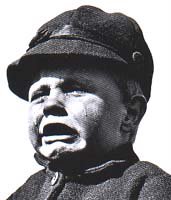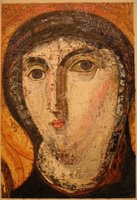I'm splitting off just one of Elizabeth's three topic-starter questions and bringing it to the top here. Gosh, maybe we need another sub-blog-- Sprucies in the Library (I am KIDDING! ;-)
I haven't decided on what to read this year. Of course, you can't lose with Schmemann's classic
Great Lent, and there are numerous works by or about the saints we commemorate in Lent, like John of the Ladder and Mary of Egypt. But in Lent particularly I always find myself drawn to journey tales, so the following titles, though perhaps a little unexpected, are some of my favorite Lenten reading:
The Silver Chair by C.S. Lewis. This is the most Lenten of the Chronicles of Narnia. It begins with sin and repentance, and tells of an ascetic journey in the harsh Northern Wilderness, where Jill and Eustace must escape captivity by Giants and subterranean creatures in their quest to rescue an enchanted prince. Along the way, Jill is required to recite a list of signs each day; and like us, she loses her way when she sets aside her daily discipline. At the darkest of moments the greatest courage and determination are required. "I'm going to live as like a Narnian as I can even if there isn't any Narnia."
Crusader by Tim Severin. The author of
The Brendan Voyage recreates a medieval journey by horseback from Ireland to the Holy Land. A great way to learn what the realities of pilgrim journeys were like in the old days. And of course Brendan Voyage itself demonstrates the possibilities of the Irish Saint's sea journey—the ancient account may seem like some flight of fancy, but the re-enactment of the voyage from Ireland to North America in a skin boat shows the tale is not so far-fetched after all.
As long as we're on the journey theme, try any of the travel books of H.V. Morton—titles include
In the Footsteps of St. Paul. Morton was an English traveller in the early part of the 20th C, and his books are still easily available in second hand shops. Like Severin he has not just the essential curiosity but the humility of the great traveller, respect for the people and customs he encounters. Morton, travelling many decades earlier than Severin, encountered a Holy Land that was still in many respects like it was in the First Century.
Lastly, because most of us are not desert monks but are making our Lenten journey in the company of our fellow parishioners: Richard Adams'
Watership Down. This book should be required reading for all seminarians and indeed for anyone, lay or clerical, interested in establishing a mission. It contrasts in detail the differences between healthy and unhealthy communities, including the importance of tradition, freedom, teamwork, and many other things; and it provides a paradigm of steady balanced leadership, a priestly leadership in which the Chief Rabbit must "Be El-ahrairah to his people" in self-sacrifice, healing, nurturing the weak, learning from others in the team and providing them opportunity to use their diverse gifts. I actually wrote a whole essay on this application of this book, all done but the footnotes, never got around to sending it anywhere.....
 Those who have kept tabs on my collection of baby pictures at Flickr.com might have noticed that there are almost no photos of Deanna there. This is partly because she and I tend to visit the babies at different times, so as to give them collectively more time with their parents; and this is also partly because, on those occasions when Deanna and I do go to visit them together, she is busy feeding them and the photos I take tend to be, um, shall we say, just for the family.
Those who have kept tabs on my collection of baby pictures at Flickr.com might have noticed that there are almost no photos of Deanna there. This is partly because she and I tend to visit the babies at different times, so as to give them collectively more time with their parents; and this is also partly because, on those occasions when Deanna and I do go to visit them together, she is busy feeding them and the photos I take tend to be, um, shall we say, just for the family.









